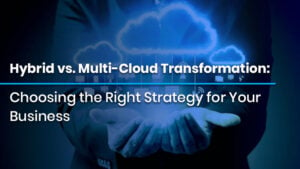
How to Strengthen Security Using CIS Controls and Posture Analysis
How to Strengthen Security Using CIS Controls and Posture Analysis Introduction In the fast-paced and ever-evolving world of cybersecurity, defending digital infrastructure goes far
🔥Premium Monthly Plan – Only $11.99!🔥Hurry! This exclusive deal won’t last long. 👉 Subscribe Now!

How to Strengthen Security Using CIS Controls and Posture Analysis Introduction In the fast-paced and ever-evolving world of cybersecurity, defending digital infrastructure goes far

How to Prepare for the AWS Data Engineer Exam Introduction With the world becoming increasingly data-driven, organizations are depending on cloud-based systems to store, process,

Hybrid vs. Multi-Cloud Transformation: Choosing the Right Strategy for Your Business Introduction In the digital-first economy of today, cloud transformation is no longer a
Table of Contents
In today’s fast-paced digital world, businesses are under constant pressure to innovate quickly, deliver reliable services, and meet customer demands faster than ever before. Traditional IT operations often face hurdles due to siloed teams, lengthy development cycles, and the complexity of managing infrastructure. Enter DevOps, a transformative approach that bridges the gap between development and operations, enabling businesses to accelerate their software delivery process while improving efficiency and reliability.
In this blog, we will explore how DevOps is transforming IT operations and highlight key practices that drive success in a DevOps-driven organization.
Ready to elevate your IT operations with DevOps? Explore IPSpecialist’s expert-led training, hands-on labs, and resources to master DevOps practices. Whether it is automation, security, or collaboration, our courses equip you with the skills you need. Start your DevOps journey today with IPSpecialist!
DevOps is a set of practices and cultural philosophies that aim to enhance collaboration between development and operations teams. It emphasizes automation, continuous integration, continuous delivery (CI/CD), and monitoring throughout the software development lifecycle (SDLC). By integrating development and operations, DevOps promotes faster releases, improves code quality, and enhances the ability to respond to changes and incidents quickly.
In traditional IT operations, long development cycles, followed by extensive testing and delayed deployments, often slow down the release of new features or updates. DevOps transforms this by automating much of the process, allowing development teams to continuously integrate and deploy (CI/CD) code. This drastically reduces the time between writing code and seeing it in production.
For example, through automation and infrastructure-as-code (IaC), deployment times can be reduced from days or weeks to minutes or hours. This leads to a quicker response to customer needs and more frequent software updates.
One of the key cultural shifts that DevOps brings is improved collaboration. Traditionally, development and operations teams work in silos with limited communication. DevOps fosters a collaborative environment where both teams share responsibility for the success of software delivery. Tools like Slack, Jira, and Trello enable teams to communicate in real-time, share progress, and resolve issues collaboratively.
By breaking down silos, DevOps ensures that all stakeholders—developers, testers, and operations—work together to meet business goals more efficiently.
DevOps heavily emphasizes automation to streamline repetitive tasks, such as code integration, testing, and deployment. Automated pipelines (CI/CD pipelines) handle these tasks seamlessly, reducing manual effort and human errors. For example, automation tools like Jenkins, GitLab CI, and CircleCI automatically build, test, and deploy code with little to no human intervention.
This not only accelerates software delivery but also improves accuracy and consistency, minimizing the risk of downtime and failures.
DevOps introduces the concept of Infrastructure as Code (IaC), allowing teams to manage and provision infrastructure using code, rather than manual processes. Tools like Terraform, Ansible, and AWS CloudFormation enable teams to describe and manage infrastructure in a declarative way, ensuring that environments are consistent and reproducible across development, testing, and production.
IaC improves agility by enabling teams to provision new environments quickly and scale infrastructure automatically as demand grows. This ensures that resources are available when needed, leading to better performance and cost-efficiency.
Monitoring is essential to maintaining the health of applications and infrastructure in a DevOps environment. By integrating monitoring tools like Prometheus, Grafana, or New Relic, teams can track performance, identify issues, and respond to incidents in real-time. Automated alerts allow operations teams to detect issues before they impact end-users, ensuring that services remain reliable.
Feedback loops, combined with monitoring, enable rapid resolution of problems and continuous improvement of systems. Teams use data gathered from production environments to identify bottlenecks, improve performance, and refine processes.
Continuous Integration (CI) and Continuous Delivery (CD) are at the heart of DevOps. CI ensures that code is regularly integrated into a shared repository, where it is automatically tested. CD goes a step further by ensuring that code changes are automatically deployed to production. By adopting a CI/CD pipeline, teams can automate the process of building, testing, and deploying code, resulting in faster, more reliable releases.
Containers, such as Docker and Kubernetes, have become a cornerstone of DevOps practices. They allow teams to package applications and their dependencies into a portable, consistent environment. This eliminates the “works on my machine” issue, enabling applications to run seamlessly across different environments. Containers also improve resource utilization, reduce overhead, and simplify scaling.
Kubernetes, a container orchestration tool, automates the deployment, scaling, and management of containerized applications, further improving agility and resilience.
Incorporating security into the DevOps process is known as DevSecOps. Rather than treating security as an afterthought, DevSecOps ensures that security practices are embedded throughout the software development lifecycle. This includes automating security testing, conducting regular code scans for vulnerabilities, and ensuring that infrastructure is secure by default.
By integrating security into the CI/CD pipeline, teams can catch vulnerabilities early, ensuring that software is both high-quality and secure before it reaches production.
IaC enables teams to automate the provisioning and management of infrastructure through code. This leads to consistency, repeatability, and faster environment provisioning. By automating infrastructure setup, teams can avoid manual errors and ensure that environments remain aligned with the desired configuration.
IaC tools like Terraform and AWS CloudFormation allow teams to version control their infrastructure, making it easier to track changes and rollback if necessary.
DevOps success depends on fostering a culture of continuous learning and improvement. Encourage teams to stay up to date with new tools, methodologies, and best practices. Regularly evaluate processes to identify areas for optimization. Hosting hackathons, workshops, and cross-functional team meetings can spark creativity and encourage innovative solutions.
The benefits of embracing DevOps practices in IT operations are wide-ranging. These include:
DevOps has revolutionized how IT operations are conducted, transforming the way software is developed, tested, and deployed. By adopting key DevOps practices like CI/CD, containerization, IaC, and DevSecOps, organizations can achieve faster time-to-market, improved collaboration, and increased operational efficiency. However, success in DevOps also requires a shift in culture—fostering a collaborative, automation-first mindset that prioritizes continuous improvement.
As the world of IT continues to evolve, DevOps will remain a critical approach to delivering software and services in a fast-paced, competitive landscape. Businesses that embrace DevOps and its practices will be well-positioned to lead in this new era of digital transformation.
Adopting DevOps practices results in faster software delivery, improved efficiency through automation, and enhanced collaboration between development and operations teams. It also boosts security by integrating continuous security measures into the development pipeline, and supports scalability with tools like containerization and Infrastructure as Code (IaC).
DevOps improves software security through DevSecOps, which incorporates security into every phase of the software development lifecycle. This approach includes automated security testing, regular vulnerability scans, and compliance checks, ensuring that security issues are detected and addressed early in the development process.
Automation is central to DevOps, streamlining repetitive tasks such as code integration, testing, and deployment. By automating these processes, DevOps reduces manual errors, accelerates release cycles, and ensures consistent and reliable software delivery, allowing teams to focus on innovation and improving product quality.
© 2025 All rights reserved | Privacy Policy | Terms and Conditions | Sitemap | Cookie Policy




